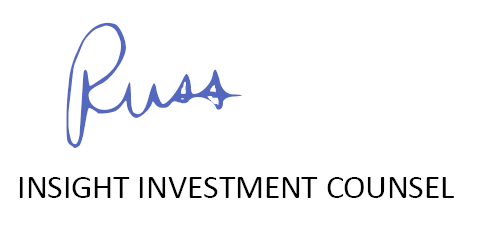Dear Clients and Friends of Insight,
I will start by sharing some astounding statistics regarding the recent positive results from corporate dividend payments. During 2023, dividend payments from U.S. public companies reached a record $602 billion, up 5% from 2022 levels! Furthermore, globally, dividend payments rose 5% to a record $1.7 trillion! These strong trends seem likely to continue and support the case for rising stock prices.
Those of you who have been reading my letters for quite some time know that I often discuss Insight’s equity investment philosophy: Invest in well-established and financially sound companies with a demonstrated ability to grow revenues and earnings, while usually paying meaningful and growing dividends to shareholders. This evaluation of a company’s dividend record is usually quite informative for both our stock market and individual company assessments.
I thought it worthwhile to revisit my very first client letter from April 2015 on why dividends are so important to stock investors. Of course, today’s market environment is different than that of 2015, most importantly because we are now challenged with higher inflation and its uncertain future. The following letter is particularly suitable today, and I reiterate my counsel.
From April 2015:
The U.S. economy has just begun its sixth year of growth following the lows stemming from the Great Recession. Much has happened since then. Perhaps more importantly, though, much remains the same. A brief inventory might include:
- Job gains continue, but underemployment and unemployment remain concerns.
- GDP growth muddles along below normal rates, occasionally dipping into the negative.
- Interest rates are low, and their inevitable rise awaits in the not-too-distant future.
- Europe remains encumbered with high debt and slow growth.
- Geopolitical turmoil spreads, seemingly unabated.
- Another election is soon upon us.
Through all these headlines, the U.S. stock markets have advanced in each of the last six years with infrequent and small disruptions. The S&P 500 is now more than 200% above its low of March 2009! Corporate profits have risen steadily, but stock prices have advanced at a greater pace resulting in higher valuations for stocks, and subsequently, greater risk. Given that future market gains are likely to be less dramatic and more frequently interrupted by significant setbacks, investors are wondering how best to navigate the next several years.
We believe that success will accrue to investors who apply a sound, fundamental approach to security selection – one that recognizes the important role of dividend income to an investor’s long-term results. Insight implements just such a process. We focus our research on established companies that are financially sound and have demonstrated that they can reliably earn a profit. These are the companies that can exploit opportunities during good times, and also prosper when times get tough. We select investments from those that we believe are most likely to pay and subsequently grow their dividends for shareholders.
But why is the payment and growth of the dividend such an important determinant of investor success? There have been numerous studies over the years that have espoused the merits of this investment approach. We’ll highlight some of their more fundamental conclusions.
- For the S&P 500, the return from dividends, or dividend yield is a modest 1.8%. However, depending on one’s time horizon, this figure meaningfully understates the dividend’s contribution to investor returns. A study of the S&P 500 since 1940 shows that, on average, the dividend comprised approximately 42% of the five-year return and 48% of the ten-year return for investors. Dividends are a very large component of an investor’s total return.
- The return from dividends is always positive. Even when stock prices decline, the dividend provides investors with a dependable reward helping to anchor a portfolio’s value. Dividends mitigate the risk of owning common stocks.
- Moderate risk does not necessitate moderate returns. A study by Ned Davis Research found that a portfolio of “Dividend Growers and Initiators” returned 9.6% per year between 1972and 2010 compared to a 7.3% return for the S&P 500, and an astoundingly low 1.7% per year for a portfolio of non-dividend paying stocks. Dividends materially enhance total returns and lead investors to above-market results.
- Ultimately what is most important for many investors is protection from inflation and its negative effect on wealth. For the period 1957-2013, the consumer price index increased at an annual rate of 3.8%. During this same period, dividend income from the S&P 500 far outpaced inflation by growing at an annual rate of 5.4%. This relationship held for periods with both low and high inflation. Dividends can grow faster than inflation and boost real purchasing power.
Companies in our clients’ portfolios have strong balance sheets. They are delivering healthy profits and building cash. These are necessary ingredients to enhance shareholder value through the payment and growth of their dividends. Based on all of the above factors these companies should add considerably to investment return while also lessening portfolio risk for our clients.

